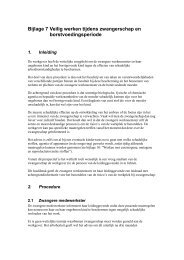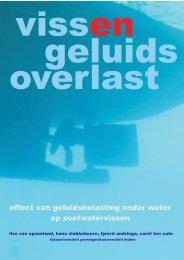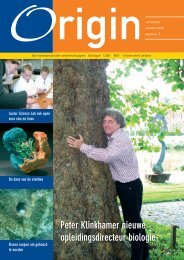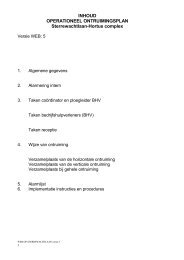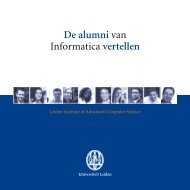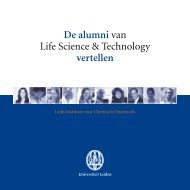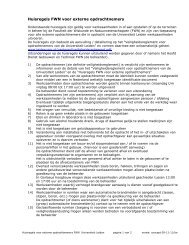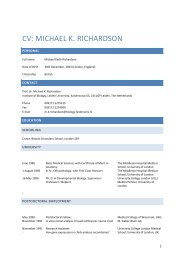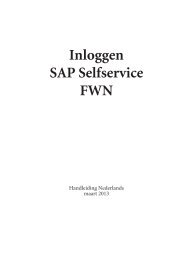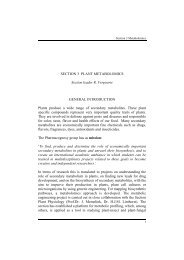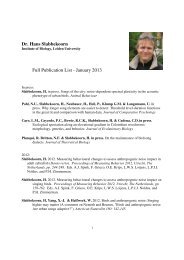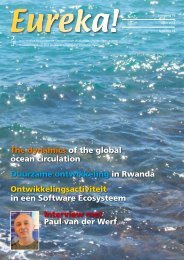infinite Beauty - Faculteit der Wiskunde en Natuurwetenschappen
infinite Beauty - Faculteit der Wiskunde en Natuurwetenschappen
infinite Beauty - Faculteit der Wiskunde en Natuurwetenschappen
Create successful ePaper yourself
Turn your PDF publications into a flip-book with our unique Google optimized e-Paper software.
sPeCial<br />
24 origin - universiteit leid<strong>en</strong><br />
A few minutes later the foldout explains that we are<br />
actually looking at a microscopic view of the Black Awl<br />
(Dutch: Zwarte Els). This is a tree and one of the most<br />
common members of the Birch family. The Black Awl<br />
has a great variety of applications.<br />
Since it is well resistant against rotting, it is used as a<br />
material for assembling the pillars un<strong>der</strong> the Rialto in<br />
V<strong>en</strong>ice and for a lot of buildings in Amsterdam.<br />
The same kind of twofold can be found in the images<br />
of the algae, which also decorate the cover of the exposition<br />
and brochure. It are beautiful gre<strong>en</strong> structures<br />
on a black background, available in differ<strong>en</strong>t shapes<br />
and almost completely symmetrical. The light blue<br />
flow results in an almost magical colour reproduction.<br />
If we zoom out, however, we observe an organism that<br />
is curr<strong>en</strong>tly used as a promising source for CO storage<br />
2<br />
as well as for biofuel applications. A last example is the<br />
portrait of Nocordia Astroides. This portrait shows<br />
a nice red, white and orange coloured structure with<br />
spine-like bulges, surrounded by layer like structures.<br />
A grey-like square plateau seems to have formed at the<br />
top. The variety in symmetry, colour and shape will<br />
mark this portrait into an attractive view. Whilst we get<br />
more and more familiar with the id<strong>en</strong>tity behind this<br />
beautiful portrait of the bacteria Nocordia Astroides,<br />
we will notice that this is a bacterium, which can lead<br />
to pneumonia in immunocompromised pati<strong>en</strong>ts. This<br />
portrait was created along with other images during<br />
an investigation in which differ<strong>en</strong>t settings of culture<br />
conditions and microscopy techniques were used, gathering<br />
crucial information. In short, this exhibition<br />
aims at putting complex and serious images from a variety<br />
of disciplines of sci<strong>en</strong>ce in a differ<strong>en</strong>t perspective<br />
for both uninitiated observers as sci<strong>en</strong>tists.<br />
the compatibl<strong>en</strong>ess of art and sci<strong>en</strong>ce<br />
As it is stated, it is possible to look with two glasses<br />
to such a masterpiece: with a pair of glasses with an<br />
artistic filter and a pair of glasses with a sci<strong>en</strong>tific filter.<br />
According to Kant, the characteristics of the work<br />
remain the same, but the impressions of the observer<br />
change. This is supported by museum Boerhaave,<br />
which states the following: “Sci<strong>en</strong>ce is a scouting expedition,<br />
by means of affirming facts, to novel truths<br />
of the reality”. Art creates its own reality and therefore<br />
calls for emotions and a feeling of exquisit<strong>en</strong>ess in the<br />
observer.<br />
This in itself is a remarkable thesis that sci<strong>en</strong>ce<br />
and art are diametrically opposed to each other. It is<br />
argued that art and sci<strong>en</strong>ce describe a differ<strong>en</strong>t reality;<br />
that one can never contain the other. It is stated<br />
that they simply operate in parallel, without<br />
boundaries and overlaps. However, we believe that<br />
there is an overlap betwe<strong>en</strong> art and sci<strong>en</strong>ce; there<br />
is beauty to be found in sci<strong>en</strong>ce without the sci<strong>en</strong>ce<br />
off the mind. Think of it: millions of researchers go to<br />
work every day, passionate about a job that can both be<br />
very positive or very negative. Have you ever had the<br />
feeling of getting one negative result after the other?<br />
Ever had the feeling of stopping an experim<strong>en</strong>t and<br />
going home? Still, there’s always light at the <strong>en</strong>d of the<br />
tunnel, a long-lasting positive result that could be the<br />
answer to many, many questions. This difficult quest<br />
of sci<strong>en</strong>ce is joined by so many people, driv<strong>en</strong> by emotion,<br />
and with passion for their work. They experi<strong>en</strong>ce<br />
beauty in sci<strong>en</strong>ce.<br />
all illustrations are ProPertY of the BoerhaaVe museum, exCePt for the Gard<strong>en</strong><br />
and the shell, WhiCh BelonG to WiKimedia Commons.




